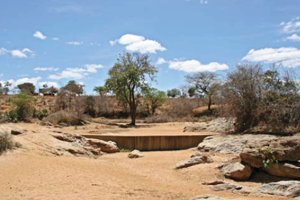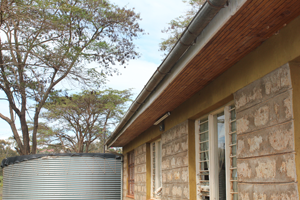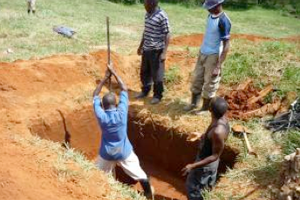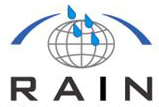Most of the layers of ground in which water is stored (aquifers) are naturally recharged, for example through rain and rivers. When the amount of extracted water exceeds the recharge, the aquifer will be depleted. Did you know that the storage capacity underground is much larger than the storage capacity of all man-made reservoirs in the world? So why not use it?
Sand dams
A sand dam is a small dam which is built on a riverbed of a seasonal river. A sand dam captures water and stores it in the sand layer. It is based on the sedimentation process of coarse sand which is stored behind the dam. In this way the natural storage capacity of the riverbed is enlarged. The sand fills with water during the wet season, resulting from surface runoff within the catchment. The riverbed is also recharged through the groundwater flow which is obstructed by the sand storage dam, creating additional groundwater storage for the community. Learn more about the technicalities behind sand dams in the videos “Sand Dams” by Excellent Development“, “Introduction to Water from Dry Riverbeds” by TheWaterChannel, or through reading the handbook “Water from Dry Riverbeds“, by Erik Nissen-Petersen. You might also find it interesting to read more about pros and cons on the sand dams by reading the blog “The Sand Dam Debate”.



(Clockwise from Top-Left) Sand Sand dam, Kitui, Kenya; Roof top harvesting; Tube recharge setup under construction
Rooftop harvesting
Did you know that a roof of 100 square meter can catch over 24,000 liters of water with a seasonal rainfall of 260 mm (which is common in arid and semi-arid regions)? Simply said: you collect the water that falls on your roof and guide it through gutters to the place where you want to store it. The challenge of rainfall being sufficient enough is not so much whether enough rain will fall over a year, but in how to substantiate the long dry season. By proper storing, sufficient water could be available. (Managing the water buffer, 2010). When the water is used as drinking water, the system needs to be equipped with first flush and filters to prevent contamination from the roof from entering the water. Also, it is important to prevent light from entering the storage system as this could enhance the growth of bacteria. In this video a family, which using a rain water harvesting system, explains how it works and shows that the water from their roof is potable.
It is common to store harvested rainwater in a tank (see picture above), but you can also let it infiltrate in the ground to recharge the groundwater and use it in the future. Recharging groundwater can be done through bore wells, recharge pits, percolation tanks, etc. This video shows through an animation how this could look like in an urban setting. Recharging groundwater with rainwater can also have other benefits, including erosion prevention from runoff and maintaining water tables. A roof top harvesting system can also be connected to tube wells. This is explained in the section below.
Tube wells
Due to changing rain patterns, erosion, vegetation losses etc., hand-dug wells can dry up at the end of the season. A simple method to recharge aquifers is by using a tube recharge (see picture above on the right side). Constructing such a system only involves a pressure pipe and a filter which costs around USD 5 to USD 20 (Securing water and land in the Tana Basin, 2012). The location for the tube recharge should ideally be up to 20 meters upstream the well that falls dry. With a step auger or a soil punch the hole can be drilled until you reach a permeable layer. This is usually at a depth of 4 to 6 meter. It is important that the recharge hole is not connected to the aquifer in order to prevent groundwater contamination. A piece of cloth covering the hole can serve as a filter. This manual of SIPHO provides you with the technical specifications to build a tube recharge. In this webinar Henk Holtslag talks about tube recharge at 16:06 min.
Resources & Read more
- Managing the water buffer, 3R group, 2010 (manual)
- Securing water and land in the Tana Basin, 3R group, 2012 (manual)
- Water from dry river beds, Erik Nissen Petersen, 2006 (manual)
- Roof water harvesting, IRC, 2007 (handbook)
- Water and community development: Rainwater harvesting and groundwater recharge, Barefoot College, 2004 (article)
- Innovative Storage of Flash Flood Water in Thailand’s Subsurface, George G. van der Meulen (paper)
- Akvopedia pages on recharge: http://akvopedia.org/wiki/Groundwater_recharge_-_general
- Rain Foundation: www.rainfoundation.org
- Rain4food network: www.rain4food.net
- Connect International: www.connectinternational.nl
- 3R (recharge, retention, reuse) group: www.bebuffered.com
- Water for Arid land: www.waterforaridland.com
